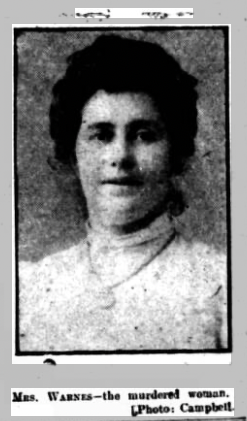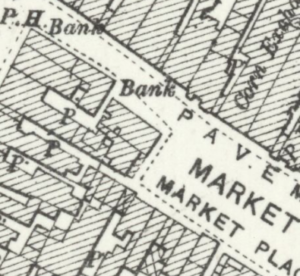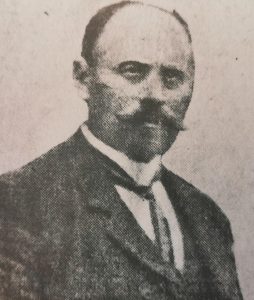Search by topic
- archaeology
- Building of Local Interest
- charity
- church
- crime
- dressmaker
- fire
- Great Eastern Railway
- Listed building
- Mapping Relief
- medieval
- oral history
- poverty
- Public House
- Rattee & Kett
- Religious House
- Roman
- scholar
- school
- Then and Now
- tudor
- women
- work
- world war one
- world war two
Search by text
 Elizabeth Warnes, 1913, St Ives
Elizabeth Warnes, 1913, St IvesTemperance Hotel, St Ives
History of the Temperance Hotel
The location of the former Temperance Hotel is in the middle of the map excerpt, under the word ‘Bank’.
It was the setting of a murder that occurred 1st Feb 1913. It was owned by Elizabeth Warnes. She was born Elizabeth Barton and had grown up in Romsey Town, Cambridge.
A detailed account can be found in ‘Cambridgeshire Murders’ by Alison Bruce.
1911
Elizabeth Warnes, 43, married, proprietress Temperance Hotel, b Cambridge
Revelations [?] May Cooper, 18, servant, b Needingworth
Clarence Osborne Chapman, boarder, 31, tailor, b Kent
James Frederick Andrews, 50, commercial traveller, b Warwicks
In 1901 the Warnes were living at 22 Halifax Road, Cambridge.
Peterborough Standard 8.2.1913
GHASTLY TRAGEDY AT ST. IVES. HOTEL LANDLADY KILLED BY A GERMAN LOVER, DETERMINED SUICIDE OF THE MURDERER. Temper and Jealousy the causes of the crime. Last Sunday morning the inhabitants of the market town of St. Ives were rudely shocked by the news that murder had been committed in their midst, and that the assailant had killed himself. The victim of the murder was Mrs. Elizabeth Warnes of the Central Temperence Hotel, Crown St. Her murderer and the suicide was German subject named Gustave Kunne who paid annual visits to this country to look after the chicory works at Fenstanton. Mrs Warnes was well-known in St. Ives and her husband (Mr William Warnes) came to reside there from Cambridge some years ago, following the late Mr. Wm. Preston in holding the licence of the Cow and Hare. Unhappily, domestic relations ended in the couple separating. The husband went to Canada after a short residence with his parents at Cambridge, and Mrs. Warnes went to reside at the Temperance Hotel three years ago last October. Shortly after this period she made the acquaintance of Kunne who was a married man with four children, and only recently lost his wife. He was a short stiffly built robust man with a very determined expression.
The couple were together on Saturday evening and walked to Railway Station to see a brother-in-law of Mrs Warnes’ off by the 8.40 p.m. train. They returned arm in arm down the Station – road, calling first at the Station Hotel and then at the Robin Hood with friend. They had drop of whisky each, treating the third member of the party to beer. They then visited another house further in the town, and had more whisky. After this time no one knows really what happened until the discovery of the tragedy. The servant maid (Ada Cooper) who was out with her sweetheart (William Walker) returned to the Temperance Hotel between nine and ten o’clock to find the place in complete darkness, and the front door locked. This did not create any suspicion, as it had happened before, so she returned to Walker’s company . Later the girl unsuccessfully sought for her mistress and Kunne at a house over the bridge which they had been in the habit of frequenting. Shortly after 11 o’clock she again went to the Hotel, only to find the same condition of affairs.
This time she tried back door which had been accidentally left unbolted and in the darkness made her way through the house to the tea room. This is immediately next to the street and was also used as a sitting room by Mrs. Warnes. Striking a match, she partially opened the door, pushing it against some heavy object on the door. Looking in she was horrified to see two bodies lying prostrate on the floor. Almost unnerved by the discovery, she ran outside and found Walker. He and the the girl hurried to the Police Station to inform Inspector Gale. That officer accompanied Cooper and Walker back. Inspector Gale with P.c. Waters entered the house, burst open the door, and found the two bodies on the ground both evidently being dead. The Inspector at once sent for Dr Grove, in the meantime lighting the gas in the room. There were but few signs of a serious struggle. The lamp globe had been broken, some of the oil spilt, the lamp vessel placed again on the table, the assumption being that the man did this before killing his victim. Mrs. Warnes was lying face downward, fully clothed. Her hat and muff were in a position which indicated that she had just returned indoors from her walk. The man was lying face upwards across the woman’s loins.
He was fist removed, when it was found that the woman been stabbed to the heart. The front of her white blouse was soaked with blood. It was discovered that the man had punctured his heart also, and that both had apparently been dead some time. Blood was splashed on the wooden skirting and the woman’s hair was dishevelled. These were the only signs of any struggle. A long-bladed clasp knife, sharp and pointed, was found in the room, and was no doubt the instrument with which the deed was done.
The police left the bodies where they were found until the afternoon when Dr. Grove made post mortem examinations. It is assumed that jealousy was the reason for the crime judging from certain letters which were sent to the unfortunate woman by Kunne and which were read at the inquest. Mrs Warnes had been twice married. She was a women of a highly excitable temperament, strong and well-proportioned. It is fairly evident that she must hare been attacked unawares as she was one well able to defend her. It is curious that no sound of any kind was heard by the passers by as the hour of the tragedy is thought by Dr. Grove to been about 9.30 p.m. Just outside on point duty was P.c. Waters, and neither he not the neighbours heard the slightest sound. The Police too were on the alert as Mrs. Warnes had complained previously to them of the German’s threats towards her and were instructed to act accordingly. The post mortem revealed the fact that the woman’s heart was pierced downwards and that the man. after withdrawing the weapon, apparently stabbed himself right through his heart. Then, with frenzied strength he pulled the knife out of his body. Curiously, too, the man’s body, excepting the puncture, bore no other traces, even of blood.
The report of the inquest follows ….
The inquest was held 3 February in the Magistrates’s Room in St Ives. The deputy coroner was A H Barratt.
In his summing up the coroner directed the jury to three options: the man had killed the woman, the woman had killed the man or it was a double suicide. The jury, after 12 minutes, returned with the verdict that Kunne had murdered Warnes and then committed suicide.
Alison Bruce draws attention to unexplained aspects of the evidence.
Contribute
Do you have any information about the people or places in this article? If so, then please let us know using the Contact page or by emailing capturingcambridge@
License
This work is licensed under CC BY-NC-SA 4.0


















